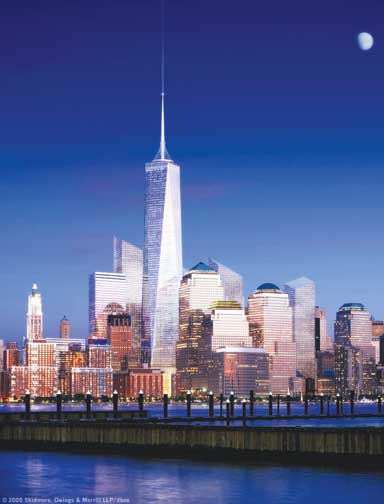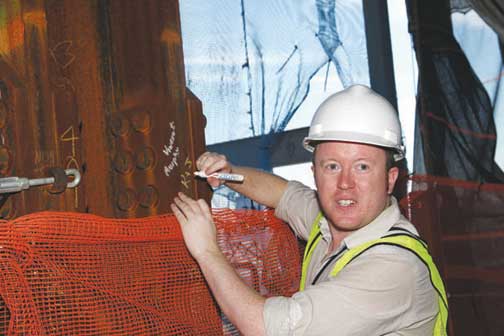


SERVICES
Tuesday September 6, 2011
At Ground Zero, A New World Trade Center Begins To Take Shape
By Vincent Murphy On Sunday next, New York will reclaim a patch of land from history. For ten years, a high perimeter fence has blocked Ground Zero from public view, but now the first piece of the re-imagined World Trade Center is set to be unveiled. The fences will move, and a permanent 9/11 Memorial Plaza will become a part of Lower Manhattan's landscape. In the footprints of where the Twin Towers once stood, two giant reflecting pools have been carved out of the ground. When water starts cascading down their granite sides next week, they will be the biggest man-made waterfalls on the planet. Called "Reflecting Absence", Michael Ared's design strikes the right tone. At once, it conveys the scale of what was lost when planes smashed into the iconic buildings a decade ago, and offers a dignified nod to the thousands who died. Towers will rise around them, and thousands of people will once again call the World Trade Center their workplace. But not here - not on the exact spot where the old towers stood and so many perished. Around the edges of the pools, carved in bronze are the names of all the victims of the Nine Eleven attacks - not just those in New York, but in Washington and Pennsylvania too. "What we hope is that the families who lost so much - husbands, wives, kids - walk out in the Plaza next week, will say that we did our job with dignity, humility and honoring the people we lost," said Bill Baroni, as he took me on a tour of the site last week. Baroni is deputy executive director of the Port Authority of New York and New Jersey, which is responsible for the rebuilding effort. The former New Jersey Senator, who holds dual Irish and US citizenship, is keenly aware of how important it is to get the memorial finished in time for the 10th anniversary. "We are doing something unique for history and all of us know that," he said. "The pressure to make sure we finished this on time was extraordinary. The entire world is watching to see if we do our job and open this memorial on time." And open on time it will. More than two hundred oak trees line the Plaza - when the entire complex is completed, there will be over 400. In amongst them stands a powerful symbol of resilience - the Survivor Tree, found in the rubble in 2001, and nursed back to health since. It was here, in May, that President Obama laid a wreath after Osama Bin Laden was killed by US Special Forces. In order to finish the plaza on time, engineers and construction workers have turned building logic on its head. Instead of building from the ground up which would have taken years, they've started building at the top. The Plaza is, in fact, a roof for the 9/11 Memorial Museum which will open next year. It's just one of the many engineering marvels that make the World Trade Center rebuilding, one of the most complex and fascinating construction projects ever. *** Eighty feet underground Bill Baroni points to some exposed stone. "One question I often get asked when I show people around is 'Where exactly is Ground Zero?' he says. "That is Ground Zero," he says pointing to the exposed stone "That is the original bedrock of the South Tower." Original steel bolts which were attached to the steel tridents of the old tower are visible in the bedrock, and above it the concrete foundation of the old building. From here those mighty towers stretched skywards. And down onto here and above where we now stood they tumbled to ruins. "It's impossible to come down here and not realize the gravity of what we're doing," says Baroni. "It's hard, you know. Three thousand people died on 9/11. More than a thousand victims have never been identified - no remains have ever been found. "For those families, indeed for all families, this truly is a sacred final resting place." *** The 9/11 National Museum will not be open until September 12th, 2011 but already the shape and layout are clear. A beautiful glass building, shimmering and reflecting the light around it, rises no higher above the ground than the oak trees beside its entrance. But inside, it stretches down three levels, most of which are still under construction. Several weeks ago, the Museum moved some of the many large precious artefacts that it will house into place. The first thing that will greet visitors are two giant steel tridents -unmistakable as the ground level facade of the Twin Towers. Other remnants that survived intact among the rubble have also been brought from storage to be exhibited - for example, the concrete stairs down which thousands ran to safety before the North Tower fell. All are covered for protection as construction continues apace around them. Drawing back the parapet on one, I'm confronted with huge piece of gnarled steel, twisted and bent out of shape. Impact steel, Barino tells me, from the part of the building where the plane struck. *** When the families of victims are given access to the Memorial Plaza on Sunday, one of the first things they're sure to do is search for the names of their loved ones among the thousands of others cast in bronze around the reflecting pool. For the first time, here they will find a permanent memorial in their honor at the place of their death. But once the tenth anniversary passes, access to the Memorial Plaza will be open to everyone. 1,500 people an hour are expected to come. While tickets are free, visitors have to pre-book a time and date on www.911memorial.org. All around the plaza, construction work will continue - the swarming visitors just another complication for workers well used to navigating the particular nature of this complex project. On the 16 acre-site, 3,500 construction workers are active around the clock, among them scores of Irish. And since the beginning, the 1 Subway train has run through the site in a specially constructed shell. The work continues around it. On the 16 acre-site, 3,500 construction workers are active around the clock, among them scores of Irish. *** On September 11, 2001, Willie O'Donnell from Listowel, Co. Kerry was working on nearby Canal Street and he witnessed the two towers crumbling with his own eyes. In Midtown, Jimmy O'Sullivan from Dunmanway in Cork was working on the 30th floor of a new high rise, when a colleague remarked to him that something was wrong when a plane passed unusually low above their heads. Together they watched the first plane fly over Manhattan and into the tall building at the other end of the island. Over in Queens, Mike Carmody from Tarbert, Co. Kerry was also working on a high rise, and had clear view of the East side of Manhattan. He remembers the second plane performing a "semi U-turn" as it smashed into the skyscraper. Little did the three men know back then, that ten years later they would be working to help the World Trade Center rise out of the ground again. All three now work at Ground Zero for Navillus, a Kerry company, responsible for much of the concrete work on the new Plaza. "It's definitely a privilege to work here," Willie O'Donnell tells me. "The day you start working here, you remember Nine Eleven, where you were and everything. "But then you get over it after a while and you just work away - just a regular pain in the ass job!" "It's great to involved," said Jimmy O'Sullivan, "It's something that you would be honored to be involved in. "I'll never forget that plane, and I'll never forget that gentleman that stood beside me and said 'There's something wrong' - that'll stay with me forever." Mike Carmody agreed that it was "an unbelievable feeling" to be working at Ground Zero. "It's a great honour to be working down here. Soon you get over that, and it just becomes a big project and a lot of headaches and a lot of schedules to meet." Another two Irish men I meet on site, work on health and safety, for Bovis, the general contractor for the Plaza and museum project. Michael Deere, from Pallasgreen in Co. Limerick has been here for five months. "We're here on the Memorial Plaza, so all the pressure was on us for the last couple of months to get it completed on time. "There's been massive progress in the last six weeks or so. Six weeks ago, you wouldn't have thought it would ever open on time." Niall Marshall from Birr, Co. Offaly, is also proud to be involved. "A lot of American people look at this as something great - a rebuilding that's going to bring everyone back together, to see this coming out of the ground again. "Obviously, it's a good feeling to come in here every day and to know that you've something to do with it." ***
Our correspondent Vincent Murphy leaves his own mark on 1 WTC From the unfinished 72nd floor of World Trade Center Tower 1, formerly known as Freedom Tower, the view of New York is spectacular in all directions. The Statue of Liberty looks the size of a Lego piece from up here, and you're already at eye level with the Empire State Building uptown. WTC 1 is already the tallest building in Manhattan, Baroni tells me, and when it's finished you will be able to see the Earth's curve from its top. The tower, when completed, will be 1776 feet tall, a height chosen because of its significance in US history (Independence), and also higher than the original towers were. Any fears that people might not want to work here seem to have been dispelled by the recent announcement that publishing giant Conde Nast will take one million square feet of the new property. The Federal Government and a Chinese bank are also signed on as early tenants. Conscious that, like all other iconic buildings in New York, the tower could become a target again once it's built, the safety measures being taken are setting new records. Each foot of steel used weighs 3,000lbs, and the concrete is 14,000lbs per square inch, seven times thicker than the concrete used in building sidewalks. "It's designed to be stronger than any office building ever built," said Baroni. As I stand on scaffolding outside where the windows of the 72nd floor are going to be installed, Bill Barino calls me back in. He hands me a white marker pen and asks me to sign a steel girder on the north side of the tower. So I write: "Vincent Murphy 01/09/11" - my signature forever etched on the interior of this historic building. "This will be someone's office one day," Baroni smiles, "You can tell them your name is written there." *** As I exit the complex, I take one last look around in an attempt to take in the scale and meaning of what I see. Most of Ground Zero is a construction site still and will be for years. It's a workplace and will be long after it's done. It's also a commuter hub. A PATH train pulls in as I leave, and hundreds of commuters swarm around me. Building has only just begun on the Transportation Hub that will rise here - a spectacular design by Spanish architect Santiago Calatrave, who was responsible for the Samuel Becket Bridge in Dublin. "It will be a downtown Grand Central," Baroni claims. It's a tourist destination - all around the perimeter people arch their necks to see Tower 1, or take pictures of themselves at a place which is part of history - and that's only likely to grow. But it's also a burial place. And it's a memorial. And on Sunday, as families gather here to remember, and the perimeter fence is taken down around the new Plaza, the reincarnation and reclaiming of the World Trade Center site will send its own message to the terrorists who came here to destroy ten years ago. |
CURRENT ISSUE

RECENT ISSUES


SYNDICATE
[What is this?]
POWERED BY

HOSTED BY

Terms of Service | Privacy Policy
Website Design By C3I







